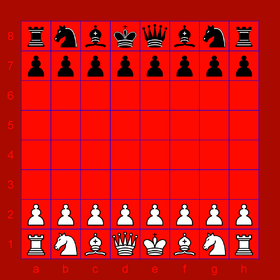Senterej

Senterej (Amharic ሰንጠረዥ sänṭäräž or Ethiopian chess) is a regional chess variant, the form of chess traditionally played in Ethiopia. It is the last popular survival of shatranj.[1][2] Senterej creates variable initial chess positions, which render the memorization of chess opening lines impracticable.
Rules
The board is not checkered, merely marked into squares; it is usually a red cloth, marked by strips of black or blue.
Pieces
- Each king (negus) stands just to the right of the centerline from its player's point of view. It moves one step in any direction as a chess king.
- At the left of the king stands the ferz, moving one square diagonally. (One source says it moves one step in any direction, but may only capture diagonally. There may have been regional variations.)
- On the flanks of the king and ferz stands a piece called the fil or alfil (saba). It leaps diagonally to the second square distant.
- Beside the fils stand the horses (feresenya), moving as chess knights.
- In the corners stand the rooks (der), moving as chess rooks.
- The second rank is filled with pawns (medeq), which move one step forward and capture one square diagonally forward. There is no double-step first move option, and therefore no en passant. A pawn reaching the farthest rank is promoted to ferz (one source says, to the rank of any piece already lost).
Gameplay
In Senterej both sides start playing at the same time without waiting for turns. The phase before first capture is called the "mobilization" or "marshalling" phase, or werera. Both players may move their pieces as many times as they like without concern for the number of moves the opponent makes. During this phase the players watch each other's moves, and retract their own and substitute others as they think best. They only start to take turns after the first capture.
The play was much more sociable than Europe is used to, with all the bystanders (even, in the old days, slaves) calling out their notions of useful plays and moving the pieces about to demonstrate.
The rules and customs surrounding checkmate are numerous. Dealing the fatal blow with a rook or knight was considered inartistic. Delivering the fatal stroke with a ferz or fil is more respectable; with a combination of pawns, even more praiseworthy. A king denuded of all pieces cannot be mated. A king with only a single piece supporting him (pawns do not count, in this case or the previous one) can only be mated before that piece has moved seven times.[3]
References
- ↑ Pritchard, D. B. (2007). The Classified Encyclopedia of Chess Variants. John Beasley. p. 247. ISBN 978-0-9555168-0-1.
- ↑ Pritchard, D. B. (1994). The Encyclopedia of Chess Variants. Games & Puzzles Publications. p. 104. ISBN 0-9524142-0-1.
- ↑ This account of the rules is taken from Murray, H. J. R., A History of Chess, Oxford University Press, Oxford, 1913, pages 362–364.
External links
- Senterej, the Ethiopian Chess
- Senterej – Ethiopian Chess with a flying start by Dr. René Gralla
- A Note on Ethiopian Chess by Dr. Richard Pankhurst
- Kaiserin setzte ein Korps matt (Neues Deutschland) (German)
- Pathguy.com a simple Ethiopian Chess program by Ed Friedlander